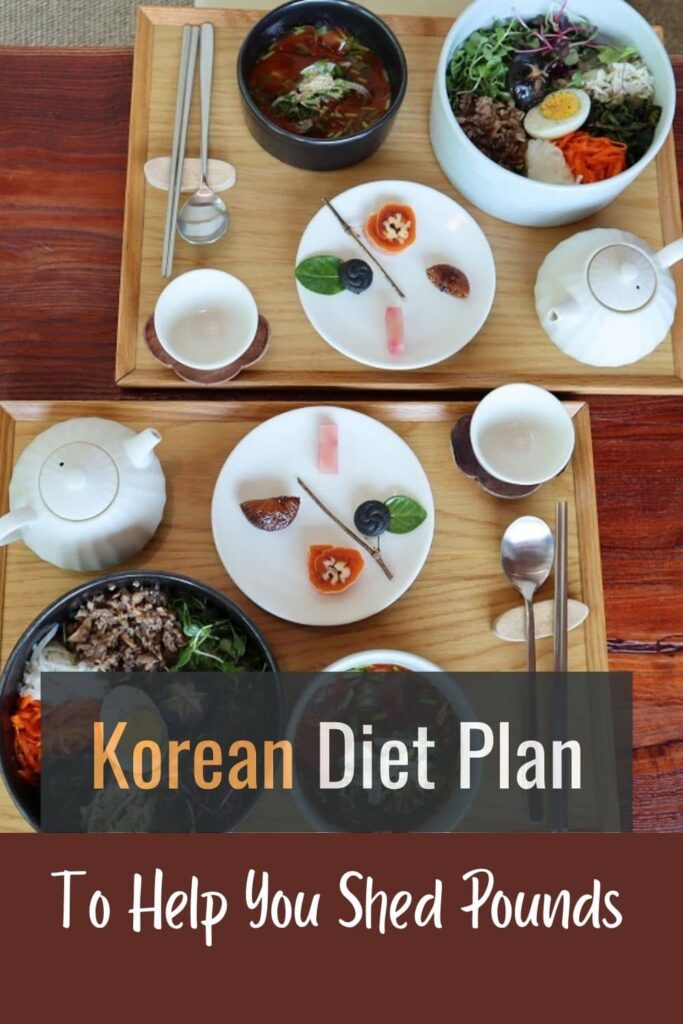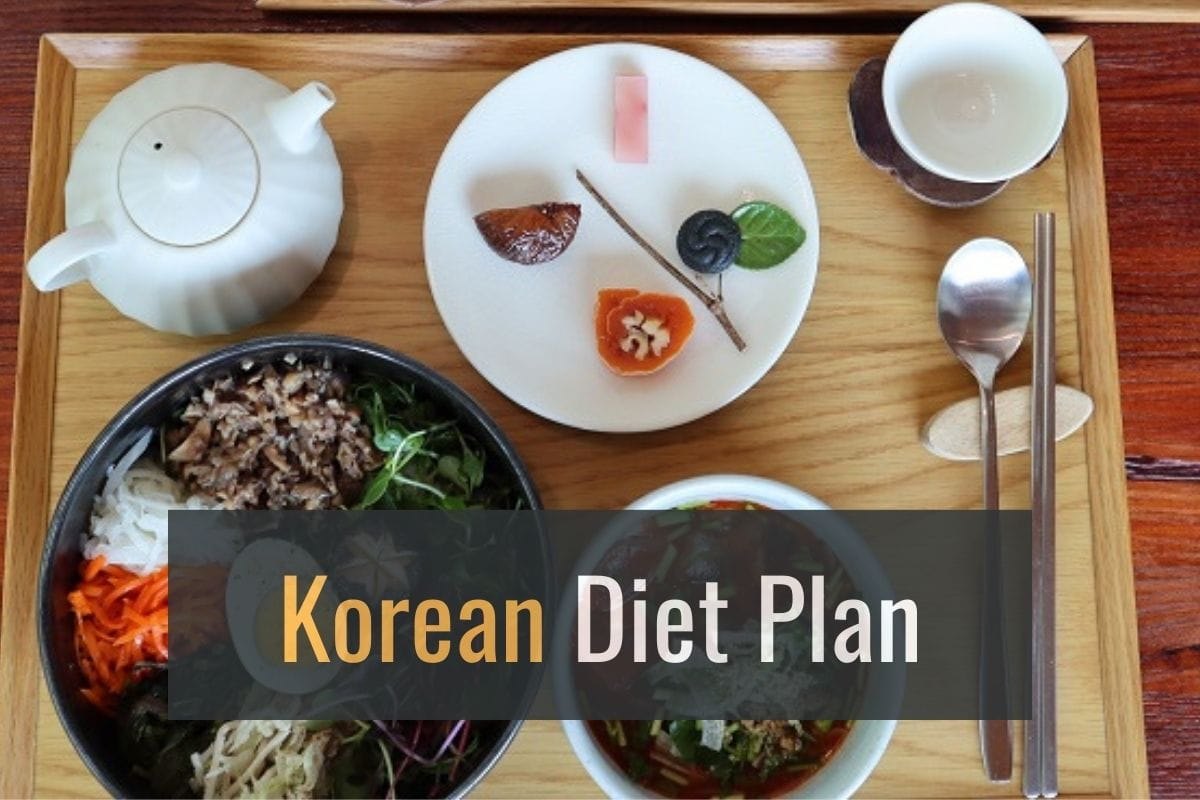The traditional Korean diet emphasizes balance, variety, and the use of fresh, whole ingredients.
Here’s a Korean diet plan you can use to lose weight while eating well.

Individual dietary needs may vary, and it’s always a good idea to consult with a healthcare professional or a registered dietitian before changing your eating habits.
※ Since dieting is a marathon, not a sprint, this Korean diet plan contains more realistic, delicious long-term meal choices you can add to your eating habits.
Day 1
Breakfast:
- Gyeran Mari (Rolled Omelette): Whisked eggs rolled with finely chopped vegetables like carrots, scallions, and bell peppers.
- Rice or Whole Grains: Steamed rice or whole grains like barley.
- Yakult: A refreshing probiotic drink for a hydrating start.
Lunch:
- Bibimbap: A mixed rice dish with various vegetables, a protein source (such as beef or tofu), and a spicy gochujang (red chili paste) sauce.
- Side Dishes (Banchan): Include an assortment of small side dishes like pickled vegetables, seaweed, and small portions of protein.
Snack:
- Fresh Fruit: Enjoy a serving of seasonal fruits.
- Roasted Edamame: A crunchy and protein-packed snack.
Dinner:
- Grilled or Steamed Protein: Choose from options like grilled chicken, fish, or tofu.
- Vegetables: Include a variety of colorful vegetables, either stir-fried or steamed.
- Rice or Other Whole Grains: Another serving of rice or whole grains.
- Kimchi: a healthy condiment that tastes great and is full of probiotics.
Evening Snack (Optional):
- Misutgaru: A multigrain smoothie with milk and a drop of honey.
Beverages:
- Green Tea: A refreshing drink you can enjoy any time of day.
- Water: Stay hydrated by drinking plenty of water throughout the day.
Day 2
Breakfast:
- Jook (Congee): Rice porridge made with water or broth, often with added vegetables, a poached egg, and a sprinkle of toasted sesame oil and soy sauce.
- Banchan: A small assortment of banchan, such as pickled radishes, seasoned spinach, and small fish.
Lunch:
- Kimchi Jjigae: A hearty kimchi stew with tofu, pork (optional), and a variety of vegetables.
- Steamed white rice: A healthy way to get carbs
Snack:
- Fruit Salad: A mix of seasonal fruits with a squeeze of fresh citrus juice.
- Roasted Seaweed Snacks: A light and crunchy snack option.
Dinner:
- Samgyeopsal (Grilled Pork Belly): Thin slices of pork belly grilled, served with garlic, ssamjang (thick, spicy paste), and fresh lettuce leaves for wrapping.
- Banchan: Include a variety of banchan like kimchi, pickled vegetables, and seasoned beansprouts.
- Steamed Rice: A serving of steamed white or brown rice.
Evening Snack (Optional):
- Yakwa: Sweet, honey-glazed cookies made with deep-fried wheat flour. Eat sparingly as it has a lot of calories.
Beverages:
- Barley Tea: A common Korean beverage, either hot or cold.
- Water: Stay hydrated throughout the day.
Day 3
Breakfast:
- Manduguk: Dumpling soup with rice cake and green onions
- Namul (Seasoned Vegetables): Sautéed or blanched vegetables seasoned with toasted sesame oil, garlic, and soy sauce.
Lunch:
- Miyeok Guk (Seaweed Soup): A light and nutritious soup made with seaweed, clams or beef, toasted sesame oil, and soy sauce.
Snack:
- Fruit Skewers: Skewers with a mix of fresh fruit chunks.
- Roasted Edamame: A crunchy and protein-packed snack.
Dinner:
- Dak Bulgogi (Grilled Chicken in Soy Sauce Marinade): Thinly sliced chicken marinated in a flavorful soy sauce mixture and grilled.
- Kongnamul Muchim (Seasoned Soybean Sprouts): Soybean sprouts seasoned with garlic, sesame oil, and soy sauce.
- Steamed Quinoa: Not Korean, but adds some variety.
Evening Snack (Optional):
- Patbingsu: Shaved ice dessert topped with sweet red beans, condensed milk, fruit, and sometimes a scoop of ice cream.
Beverages:
- Water: Stay hydrated throughout the day.
Day 4
Breakfast:
- Haemul Pajeon (Seafood Pancake): Savory pancake with a mix of seafood, green onions, and other vegetables.
- Kongguksu: Cold soybean noodle soup, perfect for a refreshing start.
Lunch:
- Kimchi Fried Rice: Fried rice cooked with kimchi, vegetables, and often a protein source like diced pork.
- Dubu Jorim (Braised Tofu): Tofu simmered in a flavorful soy-based sauce with green onions.
- Oi Muchim (Spicy Cucumber Salad): Sliced cucumbers tossed in a spicy dressing.
Snack:
- Roasted Chestnuts: A nutritious and satisfying snack.
Dinner:
- Bulgogi (Marinated Grilled Beef): Thinly sliced beef marinated in a sweet and savory soy-based sauce, grilled or stir-fried.
- Hobak Jeon (Zucchini Pancake): Pancake made with thinly sliced zucchini and a light batter.
- Ssam (Lettuce Wraps): Enjoy the bulgogi with fresh lettuce leaves for wrapping.
- Sigeumchi Namul (Seasoned Spinach): Blanched spinach seasoned with soy sauce, garlic, and toasted sesame oil.
- Steamed Brown Rice: A serving of wholesome brown rice.
Evening Snack (Optional):
- Fresh Fruit Salad: A mix of seasonal fruits.
Beverages:
- Barley Tea: A common and refreshing drink.
Day 5
Breakfast:
- Kimchi and Tofu Scramble: Soft tofu scrambled with kimchi, green onions, and a dash of soy sauce. A fusion item that’s easy to make.
Lunch:
- Doenjang Jjigae: A hearty and flavorful soybean paste stew with tofu, meat, and vegetables.
- Multi-Grain Rice: A blend of different grains for added nutritional benefits.
Snack:
- Roasted Sweet Potatoes: A hearty yet healthy snack
Dinner:
- Dak Galbi (Spicy Grilled Chicken): Marinated chicken grilled with vegetables and gochujang (Korean red chili paste).
- Banchan Assortment: Include small side dishes like pickled radishes, soybean sprouts, and kimchi.
- Kkaennip Jangajji (Pickled Perilla Leaves): Perilla leaves pickled in a soy-based sauce.
Evening Snack (Optional):
- Patjuk (Red Bean Porridge): A warm and sweet porridge made with red beans and rice.
Beverages:
- Water with Lemon Slices: Keep hydrated with water infused with lemon slices.
Day 6
Breakfast:
- Sogogi Muguk: Korean radish, beef chunks, dashima, garlic, green onions, and toasted sesame oil.
- Steamed white rice
Lunch:
- Sundubu Jjigae (Soft Tofu Stew): A spicy stew with soft tofu, vegetables, and sometimes seafood or beef.
- Mung Bean Sprout Salad: Fresh mung bean sprouts tossed in a sesame oil-based dressing.
- Brown Rice: A serving of wholesome brown rice.
Snack:
- Hoddeok (Sweet Pancakes): Korean sweet pancakes filled with a mixture of brown sugar, cinnamon, and chopped nuts.
Dinner:
- Jeyuk Bokkeum (Spicy Stir-Fried Pork): Thinly sliced pork marinated in a spicy gochujang-based sauce and stir-fried with vegetables.
- Kongnamul Guk (Soybean Sprout Soup): Light and refreshing soup made with soybean sprouts, and Korean red pepper.
- Barley Rice: A mix of barley and rice for added texture and flavor.
Evening Snack (Optional):
- Sliced cucumbers: A refreshing and satiating snack if you get hungry.
Beverages:
- Green Tea: A warm or iced drink made with matcha green tea.
Day 7
Breakfast:
- Gimbap (Korean Seaweed Rice Rolls): Rice, vegetables, and your choice of protein rolled in seaweed.
- Saenggang Cha (Ginger Tea): Warm ginger tea for a soothing start.
Lunch:
- Bibim Naengmyeon (Spicy Cold Noodles): Cold buckwheat noodles mixed with a spicy gochujang-based sauce, julienned vegetables, and a boiled egg.
- Steamed Mandu: A perfect pairing for bibim naengmyeon.
Snack:
- Sliced Persimmons: A seasonal and sweet fruit. Goes great with walnuts.
Dinner:
- Galbitang (Beef Short Rib Soup): Clear soup made with beef short ribs, glass noodles, green onions, and Korean radish.
- Ojingeo Bokkeum (Spicy Stir-Fried Squid): Tender squid stir-fried with vegetables and gochugaru (Korean red pepper flakes).
- Kkakdugi (Radish Kimchi): Cubes of radish fermented with gochugaru, garlic, and other seasonings.
- Purple Rice: A serving of nutrient-rich black rice.
Evening Snack (Optional):
- Gangjeong: Traditional Korean sweet rice puffs coated in a honey or malt syrup.
Beverages:
- Sikhye: Sweet rice drink with a hint of cinnamon and pine nuts.
Remember to tailor the meal plan to your individual needs and preferences. Additionally, it’s always a good idea to consider portion sizes and listen to your body’s hunger and fullness cues. If you have specific dietary concerns or health conditions, consult with a healthcare professional or a registered dietitian for personalized advice.
Notes:
- Vegetarian Option: Substitute meat with protein sources like tofu or tempeh if you prefer a vegetarian or vegan diet.
- Balance: Aim for a balance of protein, carbohydrates, and healthy fats in each meal.
- Seasonal Ingredients: Take advantage of local seasonal produce for optimal freshness and flavor.
- Protein Balance: Include a variety of protein sources such as seafood, poultry, and plant-based options.
- Whole Grains: Experiment with different whole grains like brown rice, barley, and purple rice.
- Spice Level: Adjust the spiciness level in dishes according to your preference.
- Hydration: Stay hydrated with a variety of healthy beverages.
- Dessert Moderation: Enjoy sweet treats in moderation as part of a balanced diet.
- Homemade Sauces: Experiment with homemade sauces using ingredients like garlic, ginger, soy sauce, and toasted sesame oil to enhance flavors.
- Mindful Eating: Practice mindful eating by savoring each bite and paying attention to hunger and fullness cues.
- Colorful Plate: Aim for a variety of colorful vegetables to ensure a diverse range of nutrients.
- Moderation in Seasoning: While Korean cuisine is flavorful, be mindful of sugar and sodium intake, especially if using soy sauce or other salty condiments.
- Avoid Excessive Sugary Drinks: Minimize the intake of sugary beverages.

Here are the main dishes that can be meal prepped.
Kimchi jjigae: kimchi, pork and/or tofu, spoonful of toasted sesame oil, spoonful of doenjang paste or miso, spoonful of soy sauce and a drop of honey
Miyeokguk: miyeok (seaweed), cubed beef or clams, spoonful of toasted sesame oil, gukganjang (concentrated soy sauce)
Doenjang stew: sliced pork, tofu, sliced onions, spoonful of doenjang paste or miso, spoonful of soy sauce and a drop of honey
Sundubu Jjigae (Soft Tofu Stew): soft tofu, spicy sundubu paste, mushrooms, seafood or beef, green onions and crack an egg over after it’s cooked
Sogogi Muguk (Korean Radish Stew): Korean radish, beef chunks, dashima, garlic, green onions, and toasted sesame oil.
Then all you’ll need then is some rice to make a hearty meal.
This plan can be incorporated into your existing diet by adding one day a week and gradually increasing frequency. I personally eat Korean food 3 to 4 times a week.
Did we miss anything?
Let me know if you have any questions about Korean diet plans!




